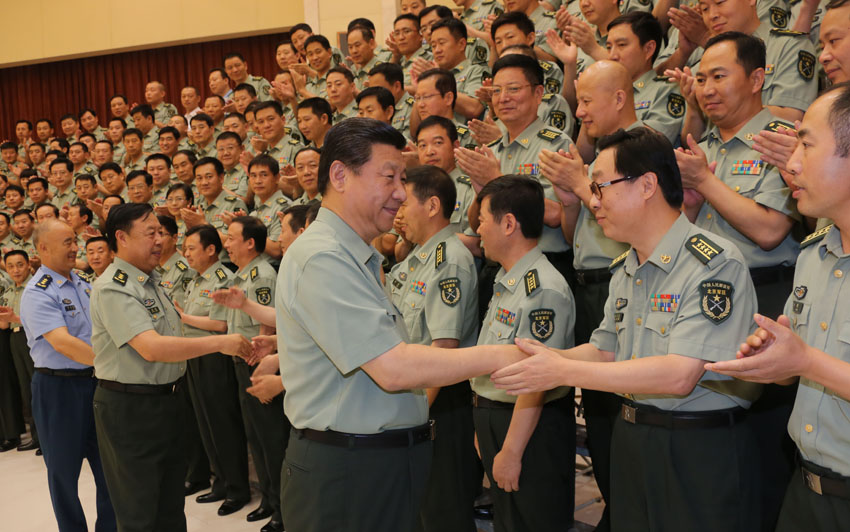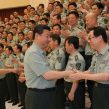
Third Plenary Session Calls for PLA Reform and Restructuring
Publication: China Brief Volume: 13 Issue: 23
By:

The reforms announced by the recent Third Plenary Session of the 18th Central Committee were headlined by economic pronouncements, but also contained ambitious language on the reform and restructuring of the Chinese military. The details remain sketchy, but according to the communiqué and subsequent press articles areas include adjusting the force mix according to the security requirements of various directions, reducing non-combat institutions and personnel, greater innovation in military theory, strengthening military leadership, building a system to generate greater warfighting capability, reform of military colleges and unit joint training, noncommissioned officer (NCO) system, strengthening military-civilian integration, improving weapons development and procurement, and improving the joint operation command system (Xinhua, November 16; on NCO reform, see China Brief, Volume XI, Issues 18 and 20).
Most of these proposals are not new. Rather, they are extensions of previous rounds of reform aimed at streamlining and modernizing the Chinese miltary, and political endorsements of reform ideas that have already circulated among military research institutions. Of all the proposals, institutional and cultural changes within the Chinese military could be the most important. A National Defense University (NDU) publication argued that the parochial interests of the services and institutional conflicts within the People’s Liberation Army (PLA) are the main constraints to transformational efforts (SOSS, p. 244; 100 Questions, pp. 196–197 * ). Overcoming them would require a bold initiative to alter the PLA’s command and institutional structure , which currently give the Army a dominant role. Since many of the newly announced reforms have been modernization areas for the past decade, the proposal could indicate that previous efforts have fallen short of the mark, and require adjustments and reinforcements.
The 2003–2005 PLA reductions included non-combat personnel and institutions, streamlining staffs, and some consolidation of military educational institutes. Since then, the PLA has conducted additional adjustments of force structure and reform of professional military education, the NCO corps, as well as researching new operational theories and methods such as integrated joint and system of systems operations. Recent PLA publications have stressed force structure, command, educational, unit training, and institutional changes required to support these emerging theoretical concepts (see China Brief, Volume XII, Issue 8, “System of Systems Operational Capability: Impact on PLA Transformation”).
Many of the reform areas announced by the Third Plenary Session have been a focus of discussion in PLA publications during the past few years to support the implementation of joint and system of systems operations capabilities that could significantly increase PLA warfighting capabilities. The development of an integrated command information system and creation of a joint command structure are required to support these theoretical developments. The PLA is slowing developing a modern command information system for joint command (C4ISR), and there have been calls to create theater joint operational commands to replace the current Military Region headquarters, which are dominated by the ground forces. Several different command structures have been proposed, including functional-based and organization-based systems (China Military Online, July 1, November 25; SOSS, pp. 244–254).
PLA publications have also anticipated the Third Plenary Session’s call for the need to streamline the force structure, optimize force composition and combined arms capabilities, and reduce non-combat units. However, forces that the PLA views as key to evolving operational theories will continue to expand and modernize, including Army Aviation, special operations, PLA Air Force (PLAAF) offensive forces, psychological warfare, cyber operations, and space operations forces (SOSS, p. 341; 100 Questions, pp. 177–183).
System of systems and joint operations theory are already changing operational patterns and methods, leading to new educational and training requirements to address the lack of personnel with high-tech and joint operations experience, and train units on integrated information systems. Cultivating skilled personnel, especially joint commanders and staff, is viewed as critical to this effort (SOSS, pp. 342–344). Personnel training recommendations include: reforming academic training program content; increasing job rotation and cross-training efforts; expanding opportunities for joint command personnel to study abroad; and integrating academic institutes with exercises (SOSS, pp. 347–351; 100 Questions, p. 236).
Some of the reform areas coming from the Third Plenary Session are already the focus of improvements and change within the PLA. Equipment modernization, unit training, professional military education, and adjustments to force structure have been ongoing to some degree over the past decade or more, although the quality of the reforms is difficult to gauge. Developing a joint operations command structure, particularly at the theater level might be the most important recommendation, and would be a start to changing institutional and cultural impediments to transformation.
Since details of the renewed efforts have not been announced, it is too soon to say whether inclusion in a political document will lend impetus to reform and restructuring. A South China Morning Post article quoted current and retired PLA officers suggesting that any reform and restructuring efforts will be limited in scope, with small adjustments and improvements, but no sweeping changes (November 16). This assessment accords with this analyst’s observations of change within the PLA, which is generally slow, incremental, and steady towards the overall goals, with adjustments through the process as necessary. Ongoing educational reforms within the PLA will only slowly change the culture and promote greater jointness within the PLA. Implementing theater joint operations commands would be a bold gesture that could indicate a serious move to reform the PLA at a more rapid pace.
* Information System-Based System of Systems Operations Study, (Beijing: National Defense University Press, 2012), referenced as SSOS.
Information System-based System of Systems Operational Capability Building in 100 Questions (Beijing: National Defense University Press, Jun 2011), referenced as 100 Questions.





